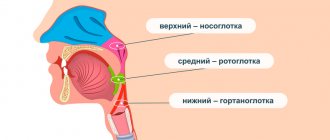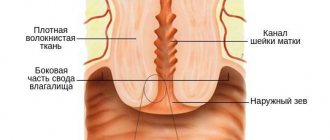Description
Pharyngitis is an inflammation of the back wall of the pharynx of an infectious, less often non-infectious nature.
Acute pharyngitis has code J02, chronic - J31.2 according to ICD-10. The pathology is manifested by a dry cough, a sensation of scratching and scratching, and soreness, which intensifies when swallowing. In acute cases, slight hyperthermia is possible. Usually the disease ends in recovery or proceeds favorably, occasionally complicated by abscesses, and becomes a trigger for the development of articular rheumatism. Pharyngitis is a widespread disease. Accounts for 5 to 9% of the total number of otolaryngological pathologies. The acute form occurs in people of all ages, is more often diagnosed in the cold season, and is usually combined with other ENT diseases: tonsillitis, rhinitis, laryngitis, sinusitis. The chronic course is typical for patients of the middle and older age groups. Men get sick more often than women.
Causes
The vast majority of cases of the disease are infectious in nature. In 70% of cases, pharyngitis is caused by viruses: rhinovirus, cytomegalovirus, members of the coronavirus and adenovirus families, and parainfluenza virus. The second place in prevalence is occupied by bacterial pharyngitis, which is most often provoked by streptococci.
Fungal forms of the disease are rarely detected; they usually develop against the background of prolonged antibiotic therapy, decreased immunity in severe chronic diseases, AIDS and other immunodeficiency states. In some cases, inflammation of the pharynx occurs as a result of an allergic reaction, after surgery, injury from foreign bodies, irritation with hot steam or liquid, contact with acids and alkalis.
Chronic pharyngitis becomes the outcome of the acute form of the disease. It is often observed in other ENT pathologies (rhinitis, sinusitis), which is associated with the spread of the inflammatory process, impaired nasal breathing and constant contact of the pharyngeal mucosa with cold atmospheric air. The abuse of drops to facilitate nasal breathing plays a certain negative role.
The chronic form of the pathology is often found in patients with gastroesophageal reflux and intestinal dysbiosis; it develops due to the reflux of acidic stomach contents into the pharynx or microflora disorders throughout all parts of the gastrointestinal tract. Sometimes the impetus for the appearance of symptoms of pharyngitis is periods of hormonal changes (menopause), untreated caries, lack of vitamin A. Risk factors include the following circumstances:
- Unfavorable environmental conditions.
- Occupational hazards: inhalation of dust, smoke, hot or cold air.
- Smoking, drinking alcohol.
- Allergic pathologies.
- Diabetes mellitus, severe heart, liver and kidney diseases.
- Decreased immunity.
Classification
Pharyngitis is classified according to several parameters:
- Acute, due to development : viral, bacterial, fungal, traumatic, allergic, caused by irritating factors.
- Chronic, by location : nasopharyngitis (the upper part of the pharynx is affected), mesopharyngitis (the oropharynx is involved), hypopharyngitis (the hypopharynx is affected).
- Chronic, by type : catarrhal, atrophic, hypertrophic.
Publications in the media
Chronic pharyngitis (CP) is a chronic inflammation of the pharyngeal mucosa, developing as a consequence of acute inflammation with inadequate treatment and unresolved etiological factors.
Classification according to pathomorphological changes • Catarrhal CP (simple) - persistent diffuse venous hyperemia, edema of the mucous membrane, dilation and stasis of small-caliber veins, dilation of the excretory ducts and hypersecretion of the mucous glands • Hypertrophic CP - replacement of the cylindrical ciliated epithelium with cubic or flat, the epithelium desquamates, forms outgrowths, cystic expansions and depressions resembling lacunae of the tonsils. Small-caliber vessels are dilated, perivascular cellular infiltration. The submucosal layer is thickened, infiltrated • Atrophic CP - most often occurs as a manifestation of atrophic rhinitis and is characterized by a sharp thinning of the pharyngeal mucosa, desquamation of the epithelial cover with the transformation of columnar epithelium into stratified squamous epithelium and a decrease in the number of mucous glands, obliteration of their canals, and hyposecretion.
Risk factors • Smoking, alcoholism, gas pollution and dust in the air (morbidity in urban areas is higher than in rural areas), incl. at work • Foci of chronic infection in the nasal cavity, paranasal sinuses, pharynx, oral cavity, nasal breathing disorders • Diseases of the cardiovascular system and genitourinary system, gastrointestinal tract, metabolic disorders, hypovitaminosis.
Clinical picture • Dryness, soreness, sensation of a foreign body in the throat, cough • Lacrimation • Sticky secretion, especially in the morning • Often complaints do not correspond to the pharyngoscopic picture - they may be insignificant or absent with pronounced changes in the pharyngeal mucosa and vice versa.
Pharyngoscopy • Catarrhal CP - hyperemia, slight swelling and thickening of the mucous membrane of the pharynx, in places the surface of its posterior wall is covered with transparent or cloudy mucus • Hypertrophic CP - the mucous membrane is hyperemic, thickened, the soft palate and uvula are swollen, pronounced congestion (superficial branching veins can be traced ), mucus on the back wall of the pharynx •• Lateral CP - hypertrophy of lymphadenoid tissue in the lateral folds of the pharynx, behind the palatopharyngeal arches, often the palatine and lingual tonsils are inflamed (the focus of chronic inflammation is the etiological factor) •• Granular CP is characterized by the presence of round or elongated lymphadenoid red formations 1-5 mm in size in the form of red granules on the back wall of the pharynx • Atrophic CP - thinning and dryness of the mucous membrane: it can be pale pink or shiny “varnish”, in places covered with a viscous purulent secretion or crusts.
Laboratory tests - see Acute pharyngitis.
Outpatient TREATMENT • Non-irritating food • Alkaline, oil, herbal inhalations • Cauterization of granules and lateral ridges of the pharynx (with hypertrophic CP) •• Medicinal method - silver nitrate 10-20% solution, trichloroacetic acid •• Physical method - galvanocaustics and cryotherapy • Alkaline water-glycerin rinses of the pharynx and massage of its posterior wall with Lugol's solution in glycerin in the atrophic form • Local administration of biostimulants into the lateral ridges of the pharynx • Physiotherapy: electrophoresis with nicotinic acid in the submandibular region, inductothermy, magnetic therapy and low-energy laser, mud applications in form of a “collar” • Inhalation of proteolytic enzymes • Sanatorium-resort treatment in a humid climate with the presence of mud and hydrogen sulfide resources.
Reduction . CP - chronic pharyngitis.
ICD-10 • J31.2 Chronic pharyngitis
Symptoms
Photo: levrudin.ru
Acute pharyngitis
The leading symptoms are soreness and soreness in the throat, slight soreness that worsens when swallowing. When the auditory tubes are involved, congestion and pain in the ears are noted. Infectious pharyngitis usually develops simultaneously with rhinitis, tonsillitis and other acute inflammatory diseases of the ENT organs, so the patient may be bothered by a runny nose, pain in the projection of the tonsils, and other manifestations.
Intoxication syndrome is not clearly expressed. Weakness and an increase in temperature to subfebrile levels may be observed. Cases of significant hyperthermia are usually associated with severe inflammation of adjacent organs or are observed in young children. Sometimes there is an increase in regional lymph nodes. Non-infectious pharyngitis occurs with normal temperature and is not accompanied by inflammation of neighboring structures.
Chronic pharyngitis
General condition is satisfactory. For catarrhal and hypertrophic forms, a typical feeling of awkwardness, rawness, and tickling in the throat is typical. Patients report discomfort when swallowing, the sensation of a foreign object that does not prevent the swallowing of food or liquid, but forces frequent swallowing movements. Patients are bothered by a cough that occurs due to the accumulation of thick discharge. Hypertrophic pharyngitis occurs with more severe symptoms.
The main manifestation of atrophic pharyngitis is a feeling of dryness in the throat. Possible dry cough, discomfort when swallowing, bad breath. Due to the dryness of the throat, patients take small sips of water whenever possible, especially during a long conversation.
Complications
Complications of pharyngitis are quite rare. Acute bacterial pharyngitis is sometimes complicated by the formation of a paratonsillar or parapharyngeal abscess. When the infection spreads, laryngitis or tracheitis occurs. Against the background of acute streptococcal pharyngitis, some patients manifest rheumatism with involvement of the heart and joints.
Diagnostics
Photo: medborisovka.ru
The main diagnostic method is pharyngoscopy. Taking into account the form of the disease, the otolaryngologist observes the following picture:
- Acute pharyngitis . Swelling, redness, and mucopurulent plaque are detected. Sometimes the process involves the arches and tonsils. Rich red granules may be detected - foci of inflamed lymphoid tissue.
- Catarrhal pharyngitis . The mucous membrane is pasty, somewhat thickened. Congestive hyperemia is noted, and accumulations of viscous mucus are detected.
- Hypertrophic pharyngitis . The same signs are visualized as in the catarrhal form, but more pronounced. With a special type of hypertrophic process - granulosa pharyngitis, dilated veins and small semicircular dark red islands, which are accumulations of lymphoid tissue, are visible.
- Atrophic pharyngitis . The mucous membrane is dull, pale, dry, shiny, with crusts and viscous discharge. Vessels are visible through the thinned mucosa.
Laboratory tests are informative for streptococcal pharyngitis. Streptatetest and culture of the discharge help determine the type of pathogen. Acute pharyngitis is differentiated from ARVI, catarrhal tonsillitis, diphtheria, measles, scarlet fever. The hypertrophic form is distinguished from pharyngeal hyperkeratosis.
Treatment
Photo: volkovysk.by
Treatment is carried out on an outpatient basis. The indication for hospitalization is the development of complications, the spread of inflammation to neighboring organs, accompanied by a significant deterioration in the patient’s condition. Conservative therapy includes drug and non-drug methods:
- Protective mode . The patient is advised to stop smoking, drinking alcohol, and eating foods that irritate the mucous membranes. You should avoid staying in dusty rooms or in the cold.
- Drug therapy . The main role in drug therapy for pharyngitis is given to local agents. If the disease is bacterial in nature and complications develop, antibiotic therapy may be possible.
- Physiotherapy . For acute pharyngitis, laser therapy, electrophoresis with potassium iodide, paraffin treatment and mud applications to the submandibular area are used. For atrophic pharyngitis, nicotinic acid electrophoresis is prescribed.
Sanitation of infectious foci is necessary: carious teeth, paranasal sinuses, tonsils. For chronic granular pharyngitis, cryotherapy, laser coagulation and ultrasonic disintegration of granules, and radio wave shading of the pharynx are used. Novocaine blockades of the lateral parts of the pharynx are performed.
Patients with pharyngitis caused by gastroesophageal reflux require treatment of the underlying disease by a gastroenterologist. In the presence of endocrine and somatic pathologies, observation by an endocrinologist, cardiologist, nephrologist, hepatologist, and other specialists is indicated.
Surgical interventions are required when complications develop, nasal breathing disorders due to other diseases of the ENT organs. For patients with parapharyngeal and paratonsillar abscesses, the abscesses are opened and drained. For chronic tonsillitis, a tonsillotomy or tonsillectomy is performed. For diseases of the nasal cavity, septoplasty, polypotomy, and vasotomy are performed.
Treatment of acute and chronic pharyngitis
F
Aringitis is an acute or chronic inflammation of the pharyngeal mucosa, which is accompanied by pain, soreness or discomfort in the throat. Since, from an anatomical point of view, the pharynx is divided into three sections - upper (nasopharynx), middle (oropharynx) and lower (hypopharynx), inflammatory processes developing here can also be divided according to their predominant localization. However, this division will be very conditional, especially in acute pharyngitis, due to the fact that acute viral and bacterial infections diffusely affect the mucous membrane of the upper respiratory tract and are migrating, often descending in nature. Morphological changes in the mucous membrane in chronic pharyngitis usually have a predominant localization in one of the anatomical parts of the pharynx, which makes it possible to tentatively identify individual nosologies, for example, chronic nasopharyngitis.
Etiology and classification
According to the etiological factor, acute pharyngitis can be divided into viral, bacterial, fungal, allergic, traumatic (as a result of a foreign body or surgical intervention) and caused by exposure to irritating factors (hot liquid or steam, acids, alkalis, radiation, etc.). Chronic pharyngitis is usually classified not according to etiology, but according to the nature of the changes developing in the mucous membrane: catarrhal (simple), atrophic (subatrophic) and hypertrophic. These forms of chronic inflammation are often combined. Thus, the presence of diffuse atrophic changes in the mucous membrane can be combined with focal hyperplasia of the lymphoid tissue of the posterior pharyngeal wall or tubopharyngeal ridges.
| Classification of pharyngitis Spicy
Chronic
|
The most common form of acute inflammation of the pharyngeal mucosa is catarrhal pharyngitis during ARVI. It is known that approximately 70% of pharyngitis is caused by viruses, including rhinoviruses, coronaviruses, respiratory syncytial virus, adenovirus, influenza and parainfluenza viruses. The most common causative agent of acute pharyngitis is rhinoviruses. Research in recent years shows that their importance is growing rapidly, and now rhinoviruses are responsible for more than 80% of acute respiratory viral infections during autumn epidemics. Viral infection is often only the first phase of the disease, and it “paves the way” for subsequent bacterial infection. In Fig. 1 and below provide information about the main pathogens of acute pharyngitis.
Rice.
1. Bacteria and fungi - the causative agents of acute pharyngitis (according to CA Dagnelie, 1994) Viruses - the causative agents of acute pharyngitis
(in descending order of frequency):
Basic:
- Rhinoviruses
- Coronaviruses
- Adenoviruses
- Influenza virus
- Parainfluenza virus
Rare:
- Respiratory syncytial virus
- Herpes simplex viruses (types 1 and 2)
- Enteroviruses
- Coxsackie virus
- Epstein–Barr virus
- Cytomegalovirus
- AIDS virus
These generalized data, taken from foreign manuals on otorhinolaryngology and infectious diseases, are very conditional, since the concept of “sore throat”, used in English (the Russian-language analogue is acute pharyngitis or pharyngotonsillitis), is not a definition of a specific nosological form, but rather a collective term for several diseases [3–6,10]. In addition to the nonspecific form, there are other types of pharyngitis associated with specific pathogens, for example, Epstein-Barr virus in infectious mononucleosis, Yersinia enterocolitica
for yersenial and gonococcus for gonorrheal pharyngitis, as well as
Leptotrix buccalis
for leptotrichosis of the pharynx.
Clinic and diagnostics
For the clinical picture of acute pharyngitis
Characterized by soreness, dryness, discomfort and pain in the throat when swallowing (especially with an empty throat), less often - general malaise, a rise in temperature. When the tubopharyngeal ridges become inflamed, the pain usually radiates to the ears. On palpation, there may be pain and enlargement of the upper cervical lymph nodes. Pharyngoscopy reveals hyperemia of the posterior wall of the pharynx and palatine arches, individual inflamed lymphoid granules, but there are no signs of inflammation of the tonsils characteristic of angina. It should be remembered that acute pharyngitis may be the first manifestation of some infectious diseases: measles, scarlet fever, rubella measles. In some cases, differential diagnosis with Kawasaki disease and Stevens-Johnson syndrome is required.
For the clinical picture of chronic pharyngitis
An increase in temperature and a significant deterioration in general condition are not typical. The sensations are characterized by patients as dryness, soreness and a feeling of a lump in the throat, which causes a desire to cough or “clear the throat”. The cough is usually persistent, dry and easily distinguishable from the cough that accompanies the course of tracheobronchitis. Discomfort in the throat is often associated with the forced need to constantly swallow mucus in the back of the throat, which makes patients irritable, interferes with their normal activities and disrupts sleep.
With atrophic pharyngitis, the mucous membrane of the pharynx looks thinned, dry, and often covered with dried mucus. Injected vessels may be visible on the shiny surface of the mucous membrane. In the hypertrophic form, pharyngoscopy reveals foci of hyperplastic lymphoid tissue randomly scattered on the posterior wall of the pharynx or enlarged tubopharyngeal ridges located behind the posterior palatine arches. At the time of exacerbation, these changes are accompanied by hyperemia and swelling of the mucous membrane, but usually the paucity of objective findings does not correspond to the severity of the symptoms that bother patients.
Chronic pharyngitis is often not an independent disease, but a manifestation of the pathology of the entire gastrointestinal tract: chronic atrophic gastritis, cholecystitis, pancreatitis. The entry of acidic gastric contents into the pharynx during sleep with gastroesophageal reflux disease and hiatal hernia is often a hidden cause of the development of chronic catarrhal pharyngitis, and in this case, without eliminating the underlying cause of the disease, any local treatment methods provide an insufficient and short-lived effect. Smoking and tonsillectomy lead to the development of atrophic changes in the pharyngeal mucosa.
Pharyngitis often develops with constantly difficult nasal breathing. It can be caused not only by switching to mouth breathing, but also by the abuse of vasoconstrictor drops, which flow from the nasal cavity into the pharynx and have an unnecessary anemic effect there. Symptoms of pharyngitis may be present with the so-called postnasal drip (postnasal drip). In this case, discomfort in the throat is associated with the flow of pathological secretions from the nasal cavity or paranasal sinuses along the back wall of the pharynx. In addition to constant coughing, this condition can cause wheezing in children, which requires differential diagnosis with bronchial asthma.
The main factors contributing to the development of chronic pharyngitis:
- constitutional features of the structure of the mucous membrane of the pharynx and the entire gastrointestinal tract;
- prolonged exposure to exogenous factors (dust, hot dry or smoky air, chemicals);
- difficulty breathing through the nose (breathing through the mouth, abuse of decongestants);
- smoking and alcohol abuse;
- allergy;
- endocrine disorders (menopause, hypothyroidism, etc.);
- vitamin deficiency A;
- diabetes mellitus, heart, pulmonary and kidney failure.
For persistent sore throat that cannot be treated with conventional therapy, differential diagnosis is required with a number of syndromes that develop in certain systemic diseases and diseases of the nervous system. Plummer–Vinson syndrome occurs in women aged 40 to 70 years against the background of iron deficiency anemia. Sjogren's syndrome is an autoimmune disease, accompanied, in addition to severe dryness of the mucous membrane of the gastrointestinal tract, by diffuse enlargement of the salivary glands. Eagle syndrome (stilalgia) is characterized by severe, persistent, often unilateral pain in the throat caused by elongation of the styloid process, which is located on the lower surface of the temporal bone and can be palpated above the upper pole of the tonsil. A number of neuralgias (glossopharyngeal or vagus nerve) can also cause sore throat, especially in older people.
Treatment
In case of acute and exacerbation of chronic pharyngitis, not accompanied by pronounced disorders of the general condition, symptomatic treatment is sufficient, including a gentle diet, hot foot baths, warm compresses on the front surface of the neck, milk with honey, steam inhalations and gargling. Smoking should be stopped. Uncomplicated pharyngitis usually does not require systemic antibiotics. In this situation, it becomes justified to carry out not systemic, but local antimicrobial therapy, which can also be prescribed in the form of monotherapy. However, a survey conducted in Belgium showed that in general, 36% of doctors resort to prescribing antibiotics for acute respiratory viral infections and pharyngitis [7]. This article will discuss drugs for the local treatment of acute and chronic pharyngitis.
The main drugs for local antimicrobial therapy presented on the Russian market are listed in Table. 1. These drugs usually contain one or more antiseptics (chlorhexidine, hexetidine, benzydamine, ambazone, thymol and its derivatives, alcohols, iodine preparations, etc.), essential oils, local anesthetics (lidocaine, tetracaine, menthol), less often – antibiotics (fusafunzhin, framycetin) or sulfonamides, deodorizing agents. Preparations may also contain bacterial lysates (Imudon), natural antiseptics (plant extracts, bee products), synthesized factors of nonspecific protection of mucous membranes, which also have an antiviral effect (lysozyme, interferon), vitamins (ascorbic acid).
Antimicrobial drugs can be prescribed in the form of rinses, insufflations, inhalations, as well as tablets and lozenges. The main requirements for drugs applied to the mucous membrane are:
- a wide spectrum of antimicrobial action, preferably including antiviral and antimicrobial activity;
- lack of toxic effect and low rate of absorption from mucous membranes;
- low allergenicity;
- no irritating effect on the mucous membrane.
Most of those listed in table. 1 drugs (Hexalize, Drill, Septolete, Faringosept, Neo-angin, Strepsils, etc.) are available in the form of tablets, lozenges or lozenges. This form of drugs has relatively low activity, and their use is limited to mild forms of the disease. In addition, the doctor should remember the toxicity of chlorhexidine, which is part of many drugs (Antiangin, Drill, Sebidine, Eludril) and should not allow their unlimited, uncontrolled use by patients (especially children).
The prescription of a number of drugs is limited by their high allergenicity and irritating effect. This includes drugs containing iodine derivatives (iodinol, iox, vocadine, povidone-iodine), propolis (proposol), sulfonamides (bicarmint, ingalipt). Preparations containing herbal antiseptics and essential oils are effective and harmless, but their use is contraindicated in patients suffering from allergies to pollen, and the number of people with this disease in some geographic areas is up to 20% of the population.
Due to the fact that within the framework of this article it is impossible to give a detailed overview of all the drugs listed in Table 5, we will focus only on those drugs that are regularly used in our practice and the effectiveness of which has been confirmed by our own experience.
Inhalation antibiotic fusafyungin (Bioparox)
– a drug that combines antibacterial properties with anti-inflammatory properties and is produced in the form of a dosed aerosol, has been used in the treatment of respiratory tract infections for more than 20 years. Due to the very small size of aerosol particles, fusafunzhin is able to penetrate into the most inaccessible parts of the respiratory tract and exert its therapeutic effect there. The high antimicrobial effectiveness of fusafyungin in acute pharyngitis, laryngitis and tracheobronchitis has been confirmed by a large number of observations. The spectrum of antimicrobial activity of fusafyungin is adapted to microorganisms that are most often the causative agents of upper respiratory tract infections; it is also active against mycoplasma infections. The unique quality of this drug is the stability of its spectrum of action: during its use, no new strains of bacteria resistant to it have emerged. In addition to antibacterial properties, fusafungin has its own anti-inflammatory effect, which has been demonstrated in experimental studies [8]. It enhances phagocytosis of macrophages and inhibits the formation of inflammatory mediators. This explains the effectiveness of the drug for viral pharyngitis, although the drug does not have a direct inhibitory effect on viruses. When prescribing fusafunzhin, a smoother course after tonsillectomy was noted [1].
Imudon
fundamentally different from all drugs used for local treatment of pharyngitis.
It is a multivalent antigenic complex, which includes lysates of 10 bacteria, as well as two causative agents of fungal infections (Candida albicans and Fusiformis fusiformis),
most often causing inflammatory processes in the oral cavity and pharynx. Imudon activates phagocytosis, helps increase the number of immunocompetent cells, increases the content of lysozyme and secretory IgA in saliva. Data have been obtained indicating that the administration of imudon for acute, as well as catarrhal, hypertrophic and subatrophic forms of chronic pharyngitis is more effective than traditional methods of treatment, such as inhalation of alkaline and antibacterial drugs, cauterization of granules with a solution of silver nitrate and the use of other anti-inflammatory and analgesic drugs [2]. If necessary, imudon combines well with local or systemic antibiotics, helping to reduce recovery time and maintain local immune defense, which is especially important during antibiotic therapy. Imudon is available in the form of lozenges.
Hexetidine
(Hexoral) is available both as a rinse solution and an aerosol. Unlike chlorhexidine, the drug is low-toxic. It is active against most bacteria - the causative agents of pharyngitis and tonsillitis, as well as fungi. In addition to being antimicrobial, hexetidine has a hemostatic and analgesic effect, which justifies its use not only after tonsillectomy and opening of a peritonsillar abscess, but also after extensive operations in the pharynx (for example, operations for obstructive sleep apnea syndrome, etc.). The combination of the above-mentioned effects with the deodorizing effect of the drug is beneficial in patients with tumors of the upper respiratory tract, in particular, those receiving radiation therapy.
Antiseptic for mucous membranes octenisept
has, perhaps, the widest spectrum of antimicrobial action, covering gram-positive and gram-negative bacteria, chlamydia, mycoplasma, fungi, protozoa, as well as herpes simplex viruses, hepatitis B and HIV. The effect of the drug begins within a minute and lasts for an hour. Octenisept has no toxic effect and is not absorbed through intact mucous membranes. We use a solution of octenisept, spraying this solution onto the mucous membranes using an insufflator [9]. Of course, the main disadvantage of this drug is that it is not available in forms convenient for independent use, and its use is mainly limited to the practice of specialized departments.
Local antibacterial agents can be widely used in the treatment of pharyngitis.
The choice of the optimal drug is determined by the spectrum of its antimicrobial activity, the absence of allergenicity and toxic effect. Of course, the most effective local drugs will not completely replace the need for systemic administration of antibiotics for sore throat and pharyngitis caused by beta-hemolytic streptococcus. On the other hand, due to the nonbacterial etiology of many forms of pharyngitis, the emergence of an increasing number of resistant strains of bacteria, as well as the undesirable effects of general antibiotic therapy, local administration of drugs with a broad spectrum of antimicrobial activity is in many cases the method of choice. Literature:
1. Luchikhin L.A., Buyanovskaya O.A., Derevyanko S.N., Paukova M.V. The effectiveness of Bioparox treatment of acute inflammatory diseases of the upper respiratory tract. Vestn. otorhinol., 1996; 2: 38–42.
2. Luchikhin L.A., Malchenko O.V. The effectiveness of the drug Imudon in the treatment of patients with acute and chronic inflammatory diseases of the pharynx // Vestn. otorhinol., 2001; 3:62–4.
3. Dagnelie CF Sore Throat in General Practice. A Diagnostic and Therapeutic Study. Thesis. Rotterdam, 1994.
4. Hansaker DH, Boone JL Etiology of Infectious Diseases of the Upper Respiratory Tract. In: Ballenger JJ, Snow JB, editors, Otorhinolaryngology: Head and Neck Surgery. 15th edition. Baltimore: Williams & Wilkins, 1996, 69–83.
5. Gwaltney JM The common cold. In: Mandell GL, Bennet JE, Dolin R, editors, Principles and Practice of Infectious Diseases. 4th Edition. NY: Churchill Livingstone - 1996, 561–6.
6. Gwaltney JM Pharyngitis. Ibid., 566–9.
7. de Melker R. Prescribing patterns for respiratory tract infections: Dutch data from international perspective. In: Program and abstracts of the 3rd International Meeting on Upper Respiratory Tract Infections. Crete, 1997, S1.
8. Otori N., Paydas G., Stierna P., Westrin KM The anti-inflammatory effect of fusafungine during experimentally induced rhinosinusitis in rabbit. Eur Arch Otorhinolaryngol 1998; 255:195–201.
9. Piskunov GZ, Piskunov SZ, Lopatin AS Substantiation of the use of Octenisept in acute and chronic inflammation of nasal mucosa. In: Liber Amicorum. Prof. Dr. EHHuizing 1976–1997. Utrecht, 1997; 181–5.
10. Rice DH Microbiology. In: Donald PJ, Gluckman JL, Rice DH, Editors, The Sinuses. New York: Raven Press, 1995, 57–64.
Combined drug -
Imudon (trade name)
(Solvay Pharma)
Combined drug -
Strepsils (trade name)
(Boots Healthcare International)
Medicines
Photo: peroxide.ru
Systemic antibiotic therapy is carried out to prevent the development of purulent complications, the spread of infection to neighboring organs in case of severe intoxication, febrile temperature in patients with acute streptococcal pharyngitis. Penicillins, cephalosporins, and macrolides are effective. The rest of the treatment plan is determined by the type of pathology. For acute pharyngitis the following are used:
- Aerosol products . For spraying, benzydamine, stopangin, biclotymol, allantoin, propolis, fusafungin and other aerosols are used.
- Medicines for resorption . Patients are prescribed absorbable tablets (ambazon, antiangin), dragees and lozenges (strepsils, septolete), lozenges (dyclonine).
- Other drugs . To improve the condition of the immune system, immunomodulators and general immunostimulants are recommended. For allergic pharyngitis, antihistamines are indicated.
Folk remedies
Photo: liktravy.ua
For chronic pharyngitis, lubricating the pharynx with a mixture of 0.5% Lugol and glycerin is effective. Swelling of the pharynx in the hypertrophic form decreases after rinsing with a 1% solution of table salt or pharmaceutical sea salt. To remove crusts and viscous discharge in the atrophic form, add a few drops of iodine to the saline solution.
The following folk remedies are also widely used in the treatment of acute and chronic pharyngitis:
- Herbal decoctions . You can gargle with decoctions of calendula, St. John's wort, lungwort, sage, chamomile and other medicinal herbs with anti-inflammatory effects. A tablespoon of herb is poured into a liter of water, boiled for 2-3 minutes, then used warm several times a day.
- Tincture of calendula . A spoonful of flowers requires 100 grams of 70% alcohol. The solution is infused for a week and filtered. To rinse, add 1 tablespoon of tincture to a glass of water.
- Honey, propolis and aloe . The honey is kept in the mouth until completely absorbed. Propolis is used to lubricate the pharyngeal mucosa. The most effective remedy is a mixture of 50 g of melted honey, 10 ml of pharmaceutical propolis tincture and a tablespoon of crushed aloe leaves. The mixture is used to lubricate the throat 2 times a day.
- Honey and sea buckthorn . Honey and fresh sea buckthorn berries are mixed in equal proportions, kept for a week, ground through a sieve, and then used for resorption 3 times a day.
Along with the listed methods, it is recommended to do inhalations with soda, salt, mineral water, infusions and decoctions of herbs. You can drink herbal, milk and alkaline teas to soothe your throat. For atrophic pharyngitis, applying sea buckthorn, peach, thuja, rose hip, calendula or tea tree oils to the mucous membrane is effective.
Traditional methods cannot be used at high fever, severe sore throat, progressive deterioration of the condition, allergies to components, severe liver and kidney diseases. Before using folk remedies, you should consult your doctor, because some components may be incompatible with medications prescribed by a specialist.
The information is for reference only and is not a guide to action. Do not self-medicate. At the first symptoms of the disease, consult a doctor.
Acute pharyngitis
A feeling of tickling, discomfort, difficulty swallowing, dryness and pain in the throat, sometimes radiating to the ears - who among us has not encountered such symptoms? The combination of these symptoms is most characteristic of acute pharyngitis, the incidence of which in the cold and warm seasons differs insignificantly.
Due to their development, acute pharyngitis is usually divided into viral, bacterial, fungal, allergic, traumatic (as a result of a foreign body or surgical intervention) and caused by exposure to irritating factors (hot liquid or steam, acids, alkalis, radiation, etc.) [1]. The most common form of acute inflammation of the pharyngeal mucosa is catarrhal pharyngitis during ARVI. It is known that approximately 70% of pharyngitis is caused by viruses, including rhinoviruses, coronaviruses, respiratory syncytial virus, adenovirus, influenza and parainfluenza viruses. It is believed that among the bacterial pathogens of acute pharyngitis, the leading role belongs to beta-hemolytic streptococcus of group A: 15–30% of cases in children and 5–17% of cases in adults, relatively rarely (<5%) can be caused by streptococci of groups C and G [6 ]. In 90% of cases, the bacterial flora of the posterior pharyngeal wall is represented by associations of 2–3 types of microbes [4].
Severe pain syndrome in acute pharyngitis is explained by the rich innervation of the pharynx [2]. The pharynx receives sensory, motor and autonomic innervation from the pharyngeal plexus, located on the outer surface of the middle pharyngeal sphincter under the buccal-pharyngeal fascia. This plexus is formed by the branches of the glossopharyngeal and vagus nerves, as well as sympathetic fibers of the superior cervical ganglion. Sensitive innervation of the pharynx is mainly carried out by the glossopharyngeal nerve, but in the area of the pharyngeal openings of the auditory tubes there are nerve connections with the second branch of the trigeminal nerve. The superior laryngeal nerve, a branch of the vagus, also takes part in the innervation of the laryngopharynx. The richness of nerve connections explains the possibility of irradiation of pain in diseases of the pharynx to the ear, lower jaw, etc. [3].
Medicines used for local treatment of pharyngitis can be divided into six groups: local antibiotics, antiseptics, local antimycotics, immunocorrectors, local anesthetics and anti-inflammatory drugs, homeopathic remedies [4]. Uncomplicated pharyngitis usually does not require systemic antibiotics [7]. Currently, in world otorhinolaryngology there is a tendency to use topical drugs to relieve inflammatory diseases. This is due to the increase in allergenicity in the population of most countries, the high percentage of side effects of systemic drugs and their low effect on inflammatory diseases of the pharynx [5].
It is optimal to prescribe medications for acute pharyngitis that not only have an antiseptic effect, but also can quickly relieve pain. One of these products is Strepsils Plus. Strepsils has been produced for more than 30 years and during this time it has taken a strong position in the global drug market [8].
Each tablet of Strepsils Plus contains two antibacterial components: 0.6 mg of amylmetacresol and 1.2 mg of 2,4-dichlorobenzyl alcohol, as well as 10.0 mg of lidocaine hydrochloride. Antibacterial components act on a wide range of bacteria (including Streptococcus pyogenes and Candida albicans). Thus, the drug Strepsils Plus has dual pharmacological activity, acting as a local antiseptic and anesthetic at the same time. Strepsils Plus in tablet form is prescribed to adults in a dosage not exceeding 8 tablets per day for 5–7 days.
During 2011, we observed 30 patients of both sexes (19 women and 11 men) aged 19 to 52 years with acute catarrhal pharyngitis who received Strepsils Plus as monotherapy (none of the patients received other systemic or local drugs, having antibacterial, non-steroidal anti-inflammatory, anesthetic effect). Patients received Strepsils Plus 1 tablet 5 times a day for 5 days.
At the time of initial treatment, all patients experienced pain in the throat, more pronounced when swallowing saliva, against the background of a cold, a feeling of rawness, dry throat and sore throat. During pharyngoscopy, patients showed local signs of acute inflammation: the mucous membrane of the pharynx (including the palatine tonsils) is hyperemic, mucous or mucopurulent deposits on the mucous membrane of the pharynx, individual follicles protruding on the back wall of the pharynx in the form of grains, swelling of the uvula.
The duration of treatment was 5 days, the follow-up period was 3 days.
The effectiveness of therapy was assessed according to the following criteria: clinical local symptoms (soreness in the throat, sore throat, feeling of dryness, sore throat at rest, sore throat when swallowing saliva, sore throat when eating); local signs of acute inflammation during pharyngoscopy (hyperemia of the pharyngeal mucosa, including the tonsils, mucous or mucopurulent deposits on the pharyngeal mucosa, individual follicles on the posterior wall of the pharynx protrude in the form of grains, swelling of the uvula). All symptoms were assessed on a 4-point scale, where: 0 points - absence of symptoms; 1 point - mild symptoms; 2 points - moderate severity of symptoms; 3 points - the severity of symptoms is significant.
| Rice. 1. Results of bacteriological examination of throat swabs before starting treatment with Strepsils Plus in the form of lozenges (n = 30) |
The safety of the drug was assessed based on parameters of vital functions (blood pressure (BP), heart rate (HR)) at each visit, as well as on the basis of taking into account all possible adverse events (AEs). An AE was defined as “any adverse medical event observed in a patient using a medical product, which may not have a cause-and-effect relationship with this type of treatment.” Lack of therapeutic effect was not considered an adverse event.
At initial presentation, low-grade fever was recorded in 10 patients (33.3%). The average body temperature in patients initially was 37.1 ± 0.5 °C; at the end of treatment, none of the patients had deviations in body temperature from the normative values.
A bacteriological study of culture of mucus from the pharynx before the start of treatment showed the predominance of coccal microflora (Fig. 1). In order to assess the bacteriological effectiveness of the study drugs, microbiological examination of cultures of mucus from the pharynx was performed in all patients both before the start of treatment and at the end of it.
| Rice. 2. Assessment of clinical effectiveness based on the dynamics of clinical local symptoms during treatment with Strepsils Plus (n = 30) |
During the therapy, all patients experienced a significant decrease or disappearance of symptoms such as a feeling of rawness, sore throat, dry throat, sore throat at rest, when swallowing saliva and when eating. Already within the first day of using Strepsils Plus, the severity of all symptoms significantly decreased. By the time the drug was completed (day 5), most patients had no local symptoms. The assessment of clinical effectiveness based on the dynamics of clinical local symptoms is presented in Table. 1 and in Fig. 2.
By the end of treatment, the vast majority of patients had no pharyngoscopic signs of acute inflammation of the pharynx: the complete disappearance of hyperemia of the pharyngeal mucosa, including the palatine tonsils, was recorded in 77% of patients, the disappearance of mucous and mucopurulent plaque - in 97%, the disappearance of follicles in posterior wall of the pharynx - in 83%, disappearance of swelling of the uvula - in 90% of patients (Table 2).
The results of a repeated bacteriological study showed a significant decrease in the number of cases of detection of pathogenic and opportunistic microflora during treatment with Strepsils Plus (Table 3).
Compliance was assessed as 100%. Patients observed the intervals between doses of the drug and completed the recommended course of treatment. During the study, no AEs were recorded while taking the study drugs. All patients completed the course of therapy without side effects.
Thus, as the results of the study showed, therapy with Strepsils Plus in patients with pain syndrome due to acute pharyngitis is highly effective. The ability of Strepsils Plus to reduce local symptoms was confirmed by subjective and objective data.
Literature
- Ryazantsev S.V. Etiopathogenetic therapy of acute pharyngitis: Methodological recommendations. St. Petersburg, 2007. 40 p.
- Akulich I.I., Lopatin A.S. Treatment of acute and chronic pharyngitis with the drug imudon // Treating Doctor. 2005. No. 9. pp. 90–91.
- Ryabova M. A. Sore throat - is it always a disease of the upper respiratory tract? // Directory of a polyclinic doctor. 2010. No. 1. P. 32–37.
- Luchsheva Yu. V., Izotova G. N. Local therapy for pharyngitis // Breast cancer. 2011. T. 19. No. 6.
- Egorova O. A. The feasibility of using local antimicrobial drugs in the treatment of upper respiratory tract infections // Farmateka. 2006. No. 5, p. 107–109.
- Shpynev K.V., Krechikov V.A. Modern approaches to the diagnosis of streptococcal pharyngitis // KMAH. 2007. T. 9 (1). pp. 20–33.
- Lopatin A. S. Treatment of acute and chronic pharyngitis // RMZh. 2001. T. 9. pp. 16–17.
- Magomedov M.M., Kryukov A.I., Uzdennikov A.A. Strepsils plus in the treatment of inflammatory diseases of the pharynx // Bulletin of Otorhinolaryngology. 1999. No. 1. P. 51–52.
O. V. Zaitseva, Candidate of Medical Sciences
Federal State Institution NCC of Otorhinolaryngology FMBA of Russia, State Institution MONIKI named after. M. F. Vladimirsky, Moscow
Contact information about the author for correspondence









